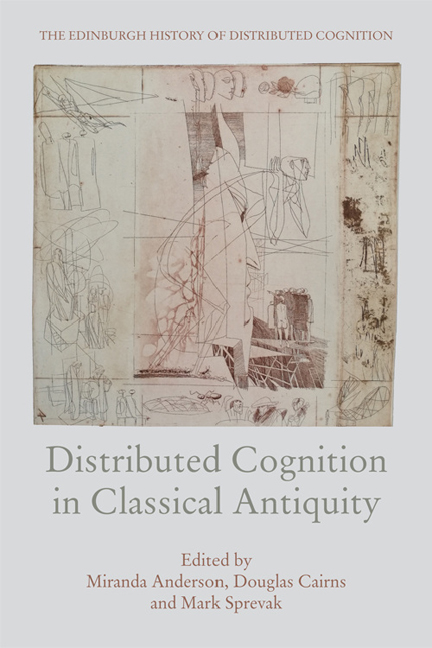Book contents
- Frontmatter
- Contents
- List of Illustrations
- Series Preface
- Miscellaneous Frontmatter
- 1 Distributed Cognition and the Humanities
- 2 Distributed Cognition and the Classics
- 3 Physical Sciences: Ptolemy's Extended Mind
- 4 Distributed Cognition and the Diffusion of Information Technologies in the Roman World
- 5 Mask as Mind Tool: A Methodology of Material Engagement
- 6 Embodied, Extended and Distributed Cognition in Roman Technical Practice
- 7 Roman-period Theatres as Distributed Cognitive Micro-ecologies
- 8 Cognition, Emotions and the Feeling Body in the Hippocratic Corpus
- 9 Enactivism and Embodied Cognition in Stoicism and Plato's Timaeus
- 10 Enargeia, Enactivism and the Ancient Readerly Imagination
- 11 Group Minds in Classical Athens? Chorus and Dēmos as Case Studies of Collective Cognition
- 12 One Soul in Two Bodies: Distributed Cognition and Ancient Greek Friendship
- 13 Distributed Cognition and its Discontents: A Dialogue across History and Artistic Genre
- Notes on Contributors
- Bibliography
- Index
5 - Mask as Mind Tool: A Methodology of Material Engagement
Published online by Cambridge University Press: 12 November 2019
- Frontmatter
- Contents
- List of Illustrations
- Series Preface
- Miscellaneous Frontmatter
- 1 Distributed Cognition and the Humanities
- 2 Distributed Cognition and the Classics
- 3 Physical Sciences: Ptolemy's Extended Mind
- 4 Distributed Cognition and the Diffusion of Information Technologies in the Roman World
- 5 Mask as Mind Tool: A Methodology of Material Engagement
- 6 Embodied, Extended and Distributed Cognition in Roman Technical Practice
- 7 Roman-period Theatres as Distributed Cognitive Micro-ecologies
- 8 Cognition, Emotions and the Feeling Body in the Hippocratic Corpus
- 9 Enactivism and Embodied Cognition in Stoicism and Plato's Timaeus
- 10 Enargeia, Enactivism and the Ancient Readerly Imagination
- 11 Group Minds in Classical Athens? Chorus and Dēmos as Case Studies of Collective Cognition
- 12 One Soul in Two Bodies: Distributed Cognition and Ancient Greek Friendship
- 13 Distributed Cognition and its Discontents: A Dialogue across History and Artistic Genre
- Notes on Contributors
- Bibliography
- Index
Summary
I live in the facial expression of the other, as I feel him living in mine.
Maurice Merleau-PontyIn many ways the Greek dramatic mask embodied the very idea of ancient theatricality: it was closely associated with the rites of Dionysus; always worn by the performers of tragedy, comedy and satyr drama; highly effective at establishing an instant performative frame; and able to project easily recognisable affective states. In ancient Athens to act without a mask would have been unthinkable. Yet today the Greek dramatic mask and how it functioned in performance are widely misunderstood. In its most reductive form it has come to symbolise drama itself, such as the use of its comic and tragic incarnations as the logo for the actors’ union in the United States. In the West the mask is now widely regarded as a passive instrument of disguise and most often associated with the inactive neutral face of the mime.
In this chapter I will explore how the mask operating within the spatial conditions of the ancient theatre acted as a superb focaliser and a highly effective distributor for the way in which spectators perceived and reacted to affective and sensorimotor information. I also attempt to explain some of the thorniest ontological problems of the mask, including the question of its duality as both object and face, and its associated uncanny or ‘magical’ properties. Ancient commentators noted that drama had the power to ‘move the soul’ (psychagōgia) and was a highly emotional and compelling experience. I will argue here that this was due in large part to the cognitive qualities of the mask. I also revisit some of my earlier research into mask functionality, which was primarily based on neuroscience (Meineck 2011), and apply a theory based on material engagement to explore how the mask significantly enhanced bodily distributed cognitive mechanisms.
To understand the cognitive functionality of the mask we need to ask not what the mask was but how it was – that is, to move away from arguments about what the mask may have represented, and instead approach it as an enactive object in its own right.
- Type
- Chapter
- Information
- Distributed Cognition in Classical Antiquity , pp. 75 - 95Publisher: Edinburgh University PressPrint publication year: 2017



